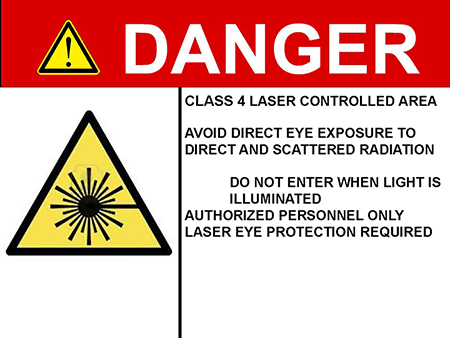
What Laser & Photobiological Safety Does
The objective of UCLA’s Laser Photobiological Safety Program (LPS) is to provide UCLA’s Educational and Research community with adequate fundamental safety guidance in maintaining a safe work environment. The LPS program reviews the potential Health Hazards posed by exposure to coherent and noncoherent photon emitting devices and the safe use of these devices.
The LPS program strives to ensure that no unintentional exposure of laser radiation in excess of the maximum permissible exposure (MPE) limit to the human eye or skin occurs. The LPS policy on laser safety requires that all lasers and laser systems are operated in a manner comparable to the American National Standards Institute (ANSI) Z136 series of Standards for the Safe Use of Lasers. Additionally, the program is designed to ensure that adequate protection against collateral hazards is provided. These collateral hazards include the risk of electrical shock, fire hazard from a beam or from use of dyes and solvents, and chemical exposures from use of chemicals and vaporization of targets.
In order to implement the policy properly while giving the greatest possible latitude to the researcher in consideration of the needs in a research setting, all laser operations at UCLA must be reviewed and approved by the UCLA Laser Safety Officer (LSO).The requirements for laser safety are multi level and include engineering controls, administrative controls, and training.
Meet the Team
Laser Safety Officer - Matt Damron
Associate Health Physicist - Arnold Eleazar
-All laser systems with maximum power of 5mW or greater
-Open beam or embedded / enclosed laser systems
Non-coherent Photon emitting
Ultraviolet, blue light and infrared LED sources and mercury lamps
Lasers are devices that produce radiant energy by the stimulated emission of light. Laser radiation is highly monochromatic, directional and coherent, which means that the beams travel and can maintain power over long distances, and can be easily and sharply focused on a small surface. Intense beams of energy may be produced in the ultraviolet, visible, near infrared and far infrared regions of the electromagnetic spectrum. Because of their precise qualities these beams pose unique and profound non-ionizing radiation hazards. As a consequence, laser usage must be carefully monitored to protect the health and safety of laboratory personnel and property within the greater University of California, Los Angeles (UCLA) campus community.




